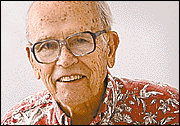


Hawaii’s World
WE are doing better in erecting statues to remind us of great leaders from our past. State Capitol District sites honor King Kamehameha, Father Damien and Queen Liliuokalani. McKinley High has President William McKinley on a pedestal. A Lincoln statue is at Ewa School. Saving isle AJAs
from internmentHonolulu city public park sites honor King Kalakaua, Princess Kaiulani, Robert Wilcox, the counterrevolutionary and Hawaii's first delegate to Congress, Duke Kahanamoku, our swimming great, and Mohandas Gandhi.
I hereby suggest an addition: a statue to honor the men, little-known today, who saved Hawaii's Japanese from mass internment in World War II. They had a faith West Coast authorities didn't have -- and they were vindicated. President Franklin Roosevelt apparently would have approved a Hawaii internment. They stood in the way.
First among them is the then-director of the Federal Bureau of Investigation in Honolulu, Robert L. Shivers.
Beside him I would have Charles Hemenway, president of the University of Hawaii regents until 1940 and a business leader as president of Hawaiian Trust Co. Hemenway would be holding a postwar letter from Shivers thanking him for "putting me on the right track."
In further detail Shivers wrote that he alone had the power to decide on Hawaii internments and releases up to the time he left Honolulu at the end of April 1943.
"It was not until I conferred with you that I began to understand the complex racial conditions in Hawaii," he wrote to Hemenway. "You gave me a group of loyal citizens of Japanese ancestry who proved invaluable in helping me shape my course."
The course was this: The Territory of Hawaii on Dec. 7, 1941, had 120,000 American citizens of Japanese ancestry and 40,000 alien Japanese, or 37.8 percent of the population.
The FBI picked up for internment only 1,441 of these or 0.9 percent of the total Japanese population. These broke down to 879 aliens, of whom 301 were subsequently released or paroled, 534 citizens, of whom 160 were released or paroled, and 28 expatriated citizens of Japanese ancestry.
The releases reduced to 980 or 0.6 percent the total sent to mainland internment camps. The citizens interned were primarily kibeis who been born in the U.S. but then went to Japan for schooling or business and later returned to Hawaii. The aliens included Japanese consular officials, Shinto priests and Japanese language school teachers, whose first loyalty was believed to be with Japan.
SHIVERS opened the FBI office here in 1939 when the likelihood of war with Japan was rising and there were increasing doubts about the loyalty of Hawaii's Japanese. He began a survey of what he later called "every phase of life in this community to determine if there were, in fact, any reasons for the suspicions that for years had been directed to the loyalty of the Japanese population."
His careful work led him to a conclusion diametrically different from that of West Coast Army commanders who evacuated and interned all 110,000 persons of Japanese ancestry.
If a third figure were to be added to the statuary, I suggest then-Col. Kendall J. Fielder, who headed G-2 intelligence operations for the Army in the Pacific. He, too, had faith in the loyalty of Hawaii's Japanese, something his naval counterparts did not share.
The decision was vindicated when the war passed without a single act of sabotage by Hawaii's Japanese. Even a large number of Japanese language school teachers had told their students to be loyal to the country where they lived.
A.A. Smyser is the contributing editor
and former editor of the the Star-Bulletin
His column runs Tuesday and Thursday.